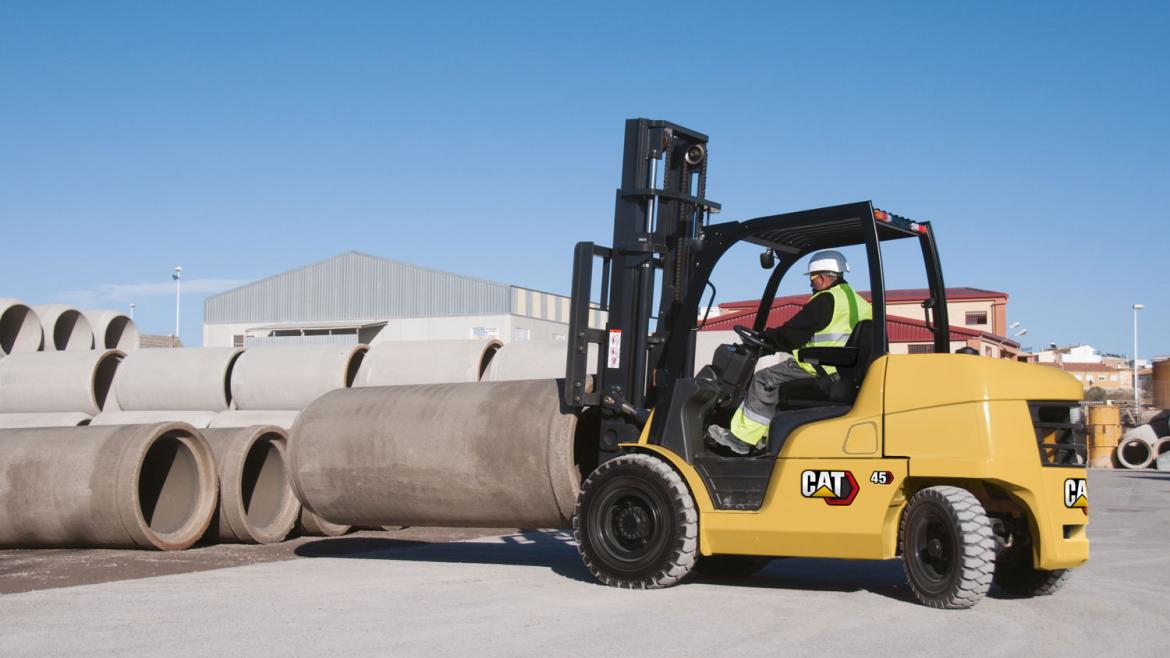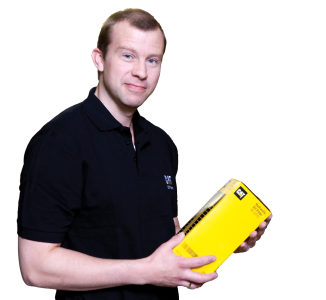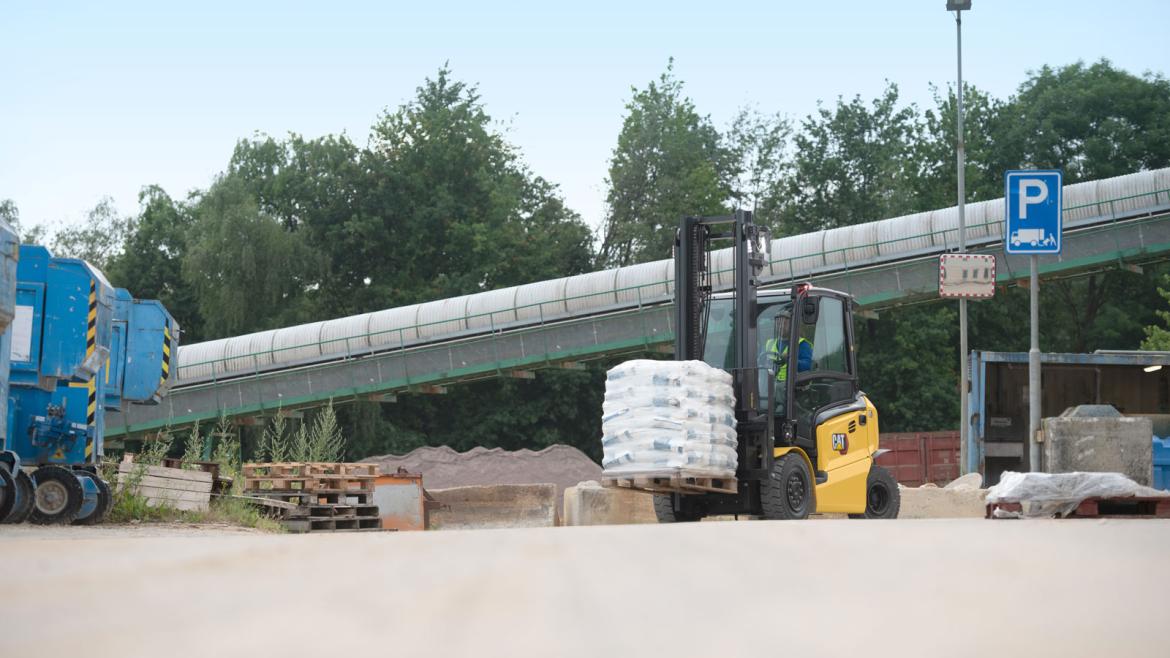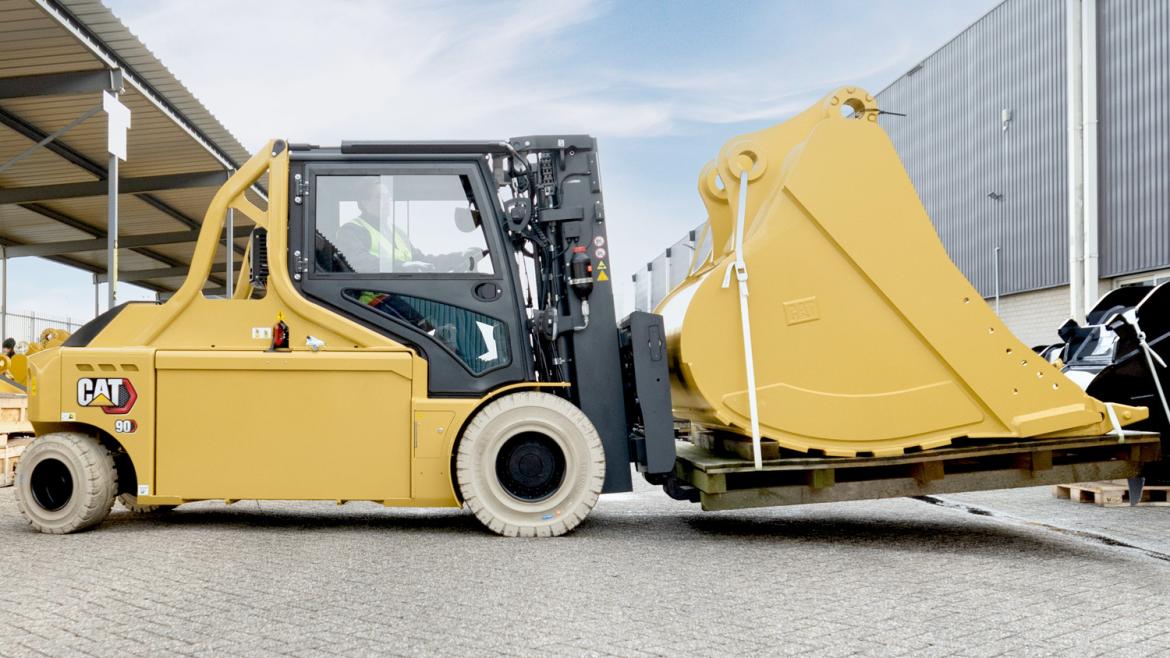

Download Construction Industry Brochure
What can Cat® forklifts do for you?
Cat® forklifts have long been a familiar sight in workplaces connected to the building and construction industry. We and our dealers are well known for providing tough ‘workhorses’. Trucks with the necessary strength and durability to thrive under harsh environments, heavy loads and intense work pressures.
You will typically see them in the depots, yards and retail centres of building material suppliers, builders’ merchants and DIY chains. They also serve in a wide variety of production sites for construction materials. In each case, businesses depend on them for a non-stop cycle of loading, unloading, internal transport, storage and retrieval.
In addition, you may find them on construction sites. There they will be unloading materials and equipment, or moving them between storage and working areas. They may even have a role in lifting items to high levels as a building takes shape.
Construction materials handled by these forklifts include:
- Bricks and blocks
- Bags of cement, sand and aggregates
- Pre-cast concrete structures
- Metal girders and other structural elements
- Wooden planks, beams and sheets
- Pipes
- Roofing, insulation, tiles and glass
- Heating, ventilation, aircon and plumbing equipment
Meeting your challenges
Heavy duties
Construction presents forklifts with some of their heaviest challenges, in every sense. From the weight and size of the loads to the long and intensive shifts. High load capacity, sturdy mast assemblies and great stability are a must. Engineering and design for reliable temperature control of engines and electric motors, in all conditions, is another important consideration.
Tough environments
Much of the work takes place outdoors, often on uneven surfaces. Rain and mud add to the difficulties. Forklifts must be designed to remain stable and maintain traction, despite rough or slippery ground. Forklift engines and electrical systems need robust quality and inbuilt protection against dust, dirt and debris generated by construction materials. Protection of lift trucks from ingress of water and mud is also vital. Meanwhile, drivers must be protected from extreme weather, vibration and noise if they are to maximise productivity.
Tight spaces and busy workplaces
On the sites where these forklifts operate, materials, equipment and structures tend to be densely packed – restricting the space for manoeuvring. As well as avoiding many obstacles, drivers need to be aware of people in their work areas. These places can be hives of activity, with a mix of tradespeople, other workers and customers. All-round vision, manoeuvrability and control are essential qualities of a productive and safe lift truck in these scenarios.
Variable loads
The weight, size and physical nature of the materials handled can vary enormously. Forklifts must be equipped to handle each load appropriately. Some items are clearly more fragile than others. However, even the hardest of blocks, for example, will break if dropped from a height. Each has a cost and a value. Handling needs to be smooth and finely controlled to enable precise movement and positioning of loads. Amongst the load types requiring special consideration are extremely long lengths of timber, metal or pipe.
Safety hazards
Construction and its associated activities can be amongst the most hazardous of occupations. The loads are heavy. The operating areas, as we have mentioned, may be full of obstacles and busy people. Visibility is fundamental to maintaining safety here. Forklift control and stability are also important in avoiding collisions, load spillages and overturns.
Sustainability
There is increasing pressure from governments, customers and the public to make construction more environmentally friendly. Forklifts and their operation form a significant part of the industry’s carbon footprint.
Competition
Intense competition and tight profit margins make the building and construction industry highly cost-conscious. When it comes to materials handling equipment, total operating cost (TCO) is key. Savings can be made through energy and fuel economy, durability and lowered maintenance requirements.
Materials handling solutions from Cat® Lift Trucks
Strong contenders
Cat diesel forklifts dominated building-related workplaces for many years, but our electric counterbalance trucks are increasingly taking over those jobs. Offering higher durability than ever, our electrics can match or beat IC engine trucks on power and performance. They also bring you extra electric advantages.
We have excellent LPG and diesel forklifts in capacities starting from 1.5 tonnes, and electrics from 1.4 tonnes. The smaller models are great for handling most materials in warehouses and yards.
For heavier and more demanding loads and conditions, however, you will need our higher-capacity ranges. With larger wheelbases and tyres, they give greater stability and heavy lifting ability. On our Cat 6.0 to 12.0 tonne electrics, high-positioned mast tilt cylinders help to maximise stability and residual capacity. In all cases, our mast and fork assemblies are dependably robust
The heaviest-duty Cat 6.0 to 12.0 tonne electrics (NH models) have an additional rear oil cooler to cope with harsh use. In our 1.5 to 3.5 and 4.0 to 5.5 tonne LPG and diesel forklifts, strong cooling systems are standard. These can be supplemented with extra cooling options.
Resilient and smooth
Cat lift trucks are famously durable, so you can use them with confidence in harsh environments. On uneven or soft ground, their low centre of gravity and advanced control systems aid stability. This can be further enhanced through your choice of tyre type and by opting for dual tyres where appropriate.
Our 4.0 to 5.5 tonne 80V electric range has electric differential locking to maximise grip on slippery surfaces. This is also a standard or optional feature – depending on model – on our smaller electrics.
To protect their engines from dust and dirt, Cat 1.5 to 3.5 and 4.0 to 5.5 tonne LPG and diesel trucks have high-positioned air intakes and enhanced filters. You can also choose optional dustproof kits. Options on the 4.0 to 5.5 tonne models include a belly plate shielding the truck undersurface. On our electric forklifts, sealing of key components like electronic controllers and brakes against water, dust and dirt is our priority.
We also look after your drivers, whose needs are always central to our designs. You can expect comfortable, spacious operating compartments, user-friendly controls and easy entry and exit. Ride quality is smooth and quiet, with low vibration levels, especially in our electric models. If you need them, we also have weatherproof cabin options with heating and/or air conditioning.
Agile and precise
In every Cat forklift, all-round vision is a fundamental design aim. We minimise obstacles and adjust truck shapes to give clear views in every direction. To give just one example, visibility through the mast on our 6.0 to 12.0 tonne electrics is ‘best in class’.
This mast’s design allows the triplex stage to nest within the duplex, while the free lift cylinders are divided into two compact parts. The dashboard and overhead guard are also specially designed to maximise the driver’s view. A rear-view camera is fitted as standard. A variety of extra mirrors and cameras can be optionally specified on any of our forklifts.
Good vision combines with compact designs, easy steering and precise control to make our trucks highly manoeuvrable. The exceptional agility of our 4.0 to 5.5 tonne electrics, for example, gives drivers the feeling of driving a much smaller truck. It features dynamic aids including OmniTurn all-wheel steering, RDS (Responsive Drive System) and intelligent curve control.
A +100⁰ rear turning axle on these models enables instant side turns, with no need for initial backward movement. The truck can turn on the spot within its own dimensions. Similar abilities are found across the capacity ranges in our electric counterbalance product collection.
Confident handling
To meet the needs of different load types, our lift trucks can be fitted with forks of varying sizes and shapes. The trucks can also adapt using optional fork positioners and side shifters. If the materials and application require clamp attachments, these can be fitted by specialised suppliers.
Engineering designed for careful, consistent control of varying loads is highlighted in our 4.0 to 5.5 tonne electrics. They feature SmoothFlow and other hydraulic technologies which optimise mast and fork movements according to load weights and lift heights. The result is smoother, faster, safer and more precise materials handling.
The hydraulic functions in our electric forklifts are controlled via light but responsive fingertip levers or, if you prefer, joysticks. They include a dual joystick option which separates functions such as clamp opening. This reduces the risk of accidentally releasing a clamped load.
One of the more specialised needs you may have in construction material supply relates to exceptionally long loads. Lengthy timbers, metal beams or pipes may be stored in racking with narrow aisles. Our four-way reach trucks are ideal for this application. Thanks to a wide hydraulic fork spreader, they can also carry smaller loads including standard pallets. This flexibility combines with fast direction changes and four-way movement – forward, back, left and right – for swift manoeuvring.
Whatever type of building material or product you are storing, and whatever your storage system, we have solutions. Our warehouse equipment range includes:
- Power pallet trucks
- Stackers
- Reach trucks
- Order pickers – low-level/2nd-level and medium/high-level
- Very narrow aisle (VNA) equipment such as man-up turret trucks or man-down VNA trucks
Built-in safety
To keep drivers and other workers safe, we design and engineer our trucks to reduce the chances of collision. Fundamentally, that means maximising the driver’s vision and the truck’s manoeuvrability, precision and control. Our braking technologies are effective, and we add automated safety aids for extra certainty. They include intelligent curve control, presence-detecting seat switches and automatic parking brakes. Comprehensive lighting options ensure the driver can see and the truck can be seen.
Smaller carbon footprint and lower costs
Advanced technologies have reduced fuel consumption in our LPG and diesel forklifts. Meanwhile, continuous improvement in our electric forklift ranges has created the most energy-efficient and environmentally friendly solutions of all.
Our 4.0 to 5.5 tonne electrics are best in class in this respect. Their consumption can be lowered even further by selecting ECO mode and choosing the Li-ion battery option. The energy efficiency of our forklifts will continue to save you money over a long product lifetime, while reducing your environmental impact.
We contribute further to sustainability through the durability of our lift trucks and their components. It means less frequent replacement of trucks and worn parts, and therefore less energy and material consumption in manufacture.
Long life, low maintenance requirements and easy service access will also reduce ongoing costs and downtime. Looking ahead, the durable quality and inbuilt protection of Cat lift trucks will help maintain a high resale value.
Constant support from Cat lift truck dealers
Wherever you are, our dealers are ready and fully equipped to support you. Their deep understanding will ensure the perfect choice and combination of lift trucks for your application. What’s more, their mobile engineers will keep them working at peak performance through expert routine maintenance and rapid response to any emergency. They have access to the fastest parts supply operation in the business.
One of the many advantages of Cat solutions is our common component strategy. High levels of component sharing between ranges maximise parts availability. This means higher first-time fix rates, less downtime and lower related costs. By cutting the number of service-related journeys, we also shrink your carbon footprint even further.
Together, we and our dealers will ensure you have everything you need. Choose Cat forklifts and services for productive, efficient and cost-effective materials handling in the construction industry.

Find Your Local Dealer
Your nearest Cat lift trucks dealer is equipped to provide maintenance services and help locate and supply the genuine parts you need.
Get started by selecting your region:

